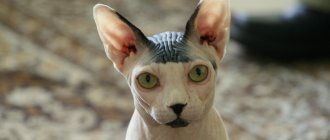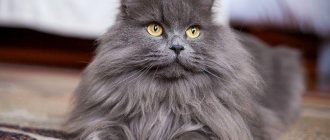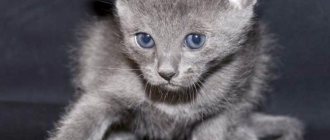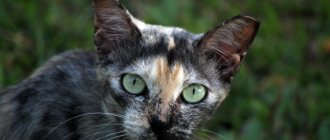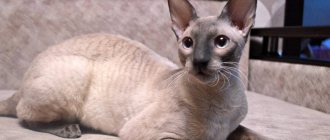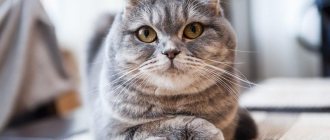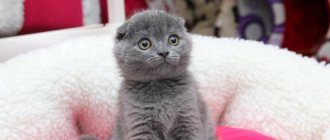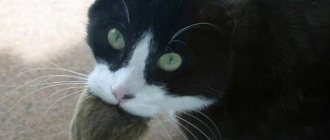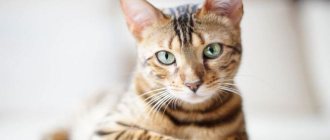History of the Canadian Sphynx breed
Canadian Sphynx
Although the breed is quite young, the existence of hairless cats is mentioned in the annals of various civilizations. The thing is that “bald” offspring can appear from completely ordinary parents as a result of a natural mutation. Most often, such animals were considered an anomaly and were discarded by humans.
There is evidence of the emergence in South America of an entire population of graceful creatures with amber-colored eyes. True, unlike Canadians, they could be partially covered with wool during the cold season, and wore mustaches all year round. It is impossible to judge the genetic characteristics of these animals today, since the breed has disappeared. The last individuals whose existence is documented lived in the 20s of the last century, but then “Inca cats,” as the Mexicans called them, did not interest professional breeders.
40 years have passed, and much further north, in the Canadian province of Ontario, the owner of a black and white short-haired cat named Elizabeth was surprised to find an unusual specimen in her pet’s litter. The kitten was given the name Prune (English: Prune) and, upon reaching maturity, was crossed with its own mother. The first experiments seemed successful, but already in the early 1970s the line was interrupted.
Around the same time, a new stage in the history of the breed began. In one of the catteries in Baden, Minnesota, two cats were devoid of fur at once. All modern elite lines trace their pedigree back to them, although the selection process, of course, included cats of different breeds. The best results were achieved by working with Devon Rexes; “naked” kittens, which were again discovered among our northern neighbors, actively participated in the creation of the breed. They were originally called “Canadian hairless cats,” but enthusiasts wanted something more sonorous and drew parallels with the oldest surviving monumental sculpture - the Egyptian Great Sphinx, which guards the peace of ancient rulers in Giza.
Recognition from international felinological organizations did not come immediately. There were concerns that the mutation was causing serious health problems. When time showed the inconsistency of these theories, The International Cat Organization (TICA) was the first to allow Sphynx dogs to participate in its exhibitions in 1986. After 6 years, champion status was received from the Canadian Cat Association (CCA), but the breed standard according to the authoritative The Cat Fanciers' Association (CFA) was approved relatively recently, in 2002.
Brief description of the breed
There are only three types of Sphynxes: Canadian, Don and Peterbald. The main difference is that Canadians have hair on their tail, paws and face.
In addition, there is a difference in appearance. For example, Dons have a fairly large, wedge-shaped head with seriously pronounced cheekbones, almond-shaped eyes and large ears. Their body is as strong as possible, their chest is wide, and their tail is well bendable. But the mustache may be completely absent.
The main difference between the Dons is the complete absence of hair. The animal has many skin folds on its body. Dons also have a high body temperature. There is no need to worry prematurely that the temperature exceeds 40 degrees. The fact is that such a cat is always hot, wet, and they are also capable of sweating.
Don Sphynx
Appearance of the Sphinx
Sphynx kittens
Sphynxes are not large breeds. Females usually weigh 3.5-4 kg, males weigh between 5-7 kg. At the same time, the body is muscular and dense, which is why cats actually turn out to be heavier than one might expect given their size. The skin is thick and gathers into characteristic folds, especially pronounced on the muzzle.
Head
Medium in size, shaped like a slightly rounded modified wedge, where the length is slightly greater than the width. The forehead is flat, the transition from it to the muzzle can be either quite soft or clearly pronounced. The muzzle is short. The cheekbones are high and clearly defined. The chin is strong and forms a perpendicular to the upper lip. The nose is short, with a slight to medium stop. The whisker pads are well developed, although the whiskers themselves are completely or almost completely absent.
Ears
Ears are one of the distinctive features of the Canadian Sphynx breed. Very large compared to the head. Upright and open. The base is wide. The inner surface is without wool.
Eyes
The eyes of sphinxes are large, shaped like a lemon, because with a wide middle part they narrow equally on both sides. Set wide and slightly slanted. The color is not regulated, but must be in harmony with the color.
Neck
Medium length, slightly arched, with well-developed muscles.
Face of the Canadian Sphynx
Body
Sphynx paws
The body of the sphinx is of medium length, muscular. The chest is wide and rounded. The belly is round and full. The back of the body is rounded.
Legs
Medium length, proportional to the body. Strong and muscular. The hind ones are slightly longer than the front ones.
Paws
Oval, with thick pads and well-developed long toes.
Tail
White Sphynx
The length of the Sphynx's tail is proportional to its body. Graceful and flexible, gradually tapering from base to tip.
Cover and skin
The skin of the Canadian Sphynx is thick and forms folds, which are especially numerous on the face and legs. They seem completely hairless, but usually the body is covered with delicate down (a length of no more than 2 mm is allowed). The norm is the presence of short, sparse hair on the outside of the ears, tail, between the toes and in the scrotum area. The bridge of the nose is covered with the usual short hair for cats.
Color
Despite the lack of hair in the usual sense, sphinxes have many colors: white, black, red, chocolate, lilac (lavender), tabby, tortoiseshell, two-color, calico (tri-color), color point, mink. Neither conflicts with the CFA standard.
What they look like
Regarding appearance, it is generally very difficult to confuse such cats with someone else. Sphynxes' bodies are always warm, have a delicate texture, and feel like a peach. Sphinxes have a good character, they are smart and sociable.
Head
The head should be slightly longer than its width. In addition, there are no clearly defined cheekbones. The skull is slightly rounded. The nose is straight, but this does not make the muzzle rough or unpleasant.
Weight
Such cats reach a weight of no more than 3.5-5 kg. They are not too big, so this mass is enough for them. We strongly do not recommend overfeeding.
Frame
Relative to the body, the body is of medium length. In addition, the body is heavy and quite muscular. Body type is considered average.
Photo of the Canadian Sphynx
Where to buy a kitten?
It is very difficult to choose a purebred kitten, especially if it concerns the Sphinx. This is a very specific breed and such cats are completely different from their furry brothers. Therefore, we advise you to choose a pet from exclusively proven nurseries or elite clubs.
Before making such a serious purchase, ask the breeders for the pedigree of the parents. Also make sure that the kitten has had high-quality vaccinations.
Little Sphinx
The character of the Canadian Sphynx
The ancient sculpture of a lion with a human head, lost in the African sands, was once called differently by Arabic speakers - Abu al-Haul, that is, the Father of Terror. But her little namesakes don’t seem at all intimidating to their owners. These are real “tails” that will follow a person everywhere and will not miss the opportunity to settle on his lap.
This sphinx has found its place
However, such affection is not at all an indicator of laziness. Sphinxes are very mischievous and playful creatures; they get involved in active fun with great excitement or independently come up with entertainment for themselves, such as “hunting” for a beetle that happens to be in the apartment. Games should be versatile and challenge not only dexterity and muscle strength, but also the intellect.
Sphinxes do not tolerate loneliness well, which should be taken into account by potential owners whose work involves frequent and long business trips. Canadians are attached not to a place, but to “their” people, so separation is a difficult test for them, even if in your absence the care of your pet is entrusted to reliable and kind hands.
Sphynxes are absolutely not aggressive, so they get along well with children of different ages and calmly share their home with other pets. Moreover, they know how to be friends with both cats and dogs, which helps brighten up the long hours of waiting to meet a person.
Representatives of this breed get used to being in large crowds of people quite easily. Thanks to this, sphinxes feel good at exhibitions, and some bring the skill of equanimity to such a level that they become real movie stars. The most striking example of this is Ted Nugent, who played the role of Mr. Bigglesworth, Dr. Evil's cat from the famous Austin Powers film series.
Pros and cons of the breed
The advantages of the breed include:
- flexible character;
- excellent interaction with children;
- amenability to training;
- excellent appetite.
The disadvantages include: fragile body, narrow head, behavior depending on the animal’s mood.
If the owner does not pay enough attention to hygiene, the animal will suffer from various dermatitis. Due to the lack of eyelashes, people often suffer from conjunctivitis.
Do not forget about timely vaccination of the animal and prevent helminths. If you do not want to breed Sphynxes, it is advisable to sterilize them.
Care and maintenance
Having no hair may seem like a big advantage to a busy owner, but in fact, Sphynx cats require even more care than their furry counterparts. The sweat and sebaceous glands in these cats work in “normal mode”, so a kind of plaque forms on the surface of the skin, which provokes the appearance of greasy stains on the owners’ clothes, bedding and upholstery.
Canadian Sphynx in a sweater
To avoid this, hygiene procedures should be carried out regularly. Some people think that it is enough to wipe the cat’s body with wet wipes that do not contain alcohol or fragrances. But most agree that the optimal solution to the problem is weekly bathing with special mild products or baby shampoo. If you accustom a kitten to them from an early age, the process will happen quickly and without much hassle. Please note that immediately after a bath the sphinx must be wrapped in a towel!
The issue of hypothermia is generally quite acute for representatives of this breed. When you hold a hairless cat in your arms, it seems really hot. The fact is that due to the lack of a fur “buffer”, heat exchange with the external environment is much more active in them than in other animals. This means that in a cool room the sphinx will freeze no less than a naked person, so buying special clothes for winter and the off-season will not be superfluous even for permanent residents of city apartments.
By the way, experienced breeders recommend exclusively keeping Canadian Sphynxes at home. If you consider it necessary for your pet to stay in the fresh air, it is better to limit its duration and monitor the cat at all times. Independent walks are contraindicated not only because of the risk of colds or sunburn (yes, Sphynx cats can get tanned and burn, so in the summer they need sunscreen!). Thanks to its characteristic appearance, even a layman can easily recognize your pet as a purebred, which means a potentially expensive animal, which can lead to kidnapping.
We didn't find a house and organized it ourselves
Other care tips differ little from the standard ones. It is important to monitor the condition of the eyes and ears to avoid infections. Regular brushing of your teeth with a special paste guarantees protection from tartar, and trimming your nails will help keep your furniture and walls in their original condition.
The cat will be grateful for a personal “house” with the opportunity to climb higher and play hide and seek, but most sphinxes prefer the owner’s bed, where you can comfortably sit under a warm blanket, to a soft bed.
All sphinxes have an excellent appetite. This is another side effect of not having fur, as they require more energy than other cats due to their intense heat exchange. The main thing is that the quality of the food is at a high level and fully satisfies your pet’s needs for proteins, fats, carbohydrates, vitamins and minerals. The easiest way to achieve this balance is with specialized premium and super premium food. But if you are willing to spend time creating a healthy menu of foods, natural nutrition will be a worthy alternative.
Leftovers are sweet
Canadian Sphynx having a meal
Caring for a Sphynx cat
Eyes
The absence of eyelashes makes the Sphynx's visual organs especially vulnerable. To prevent inflammation, your cat's eyes should be wiped daily with chamomile infusion, chilled black tea, or simply boiled water. You can use special products from the pet store.
Ears
In ordinary cats, brown discharge in the ears indicates developing diseases. For Sphynx cats, brown plaque on the inner surface of the ear is normal. Once a week, the skin should be wiped with a cotton pad soaked in lotion. After cleaning, the ears are dried and powdered with a special product purchased from a veterinary pharmacy.
Bathing
Canadians need to be washed regularly, but not too often. The optimal regime for bath procedures is once every 14–30 days. For bathing, you can use a special shampoo. Products that are not suitable for Canadian skin may cause allergic reactions and inflammation.
Wash cats with a soft sponge or hand without gloves. Water temperature is 37–39 degrees. The temperature in the room where bath procedures are carried out is also important. You need to make sure that there are no flows of cold air.
Important! A common problem with Canadian Sphynx cats is neglect of anal hygiene. To prevent your pet from soiling objects in the house with fecal residue, you need to wipe its butt and tail with hypoallergenic wipes after using the toilet.
Claws
Canadians need a manicure once every 2 months. Use sharp nippers or rounded scissors to trim the tips of the claws. This procedure is mandatory. If the claws are not trimmed in a timely manner, the cat may injure itself and the skin will become inflamed.
Cold protection
Completely hairless, Canadians are not adapted to the harsh Russian climate. Cats are quite comfortable indoors, but they need special warming clothing to walk outside. It is also necessary to organize a warm bed for sleeping and rest. The best option is a closed house. Additionally, you can organize a comfortable hammock next to the heating radiator.
Health and illness of the Sphinx
Cute sphinx
In general, with the right diet and proper care, sphinxes are infrequent patients of veterinary clinics. Problems can be caused by hypothermia, prolonged exposure to the sun, neglect of hygiene rules on the part of the owners, and lack of immunity due to missed vaccinations.
But there are also breed-specific diseases. The weak point of Canadians is sensitive skin; it can be affected by urticaria pigmentosa. Redness and rashes on the body can also be symptoms of allergies, including food allergies. Only a doctor can determine the exact cause and prescribe treatment based on test results.
Like Maine Coons, Sphynx cats suffer from hypertrophic cardiomyopathy. This dangerous heart disease is caused by a genetic mutation, but to date there is no convincing evidence that heredity has a decisive influence on its development.
But another disease of sphinxes, myopathy, is transmitted to descendants from parents. They got it in the process of selective work with Devon Rex. Progressive muscle dysfunction has no cure, progresses individually and often leads to death as a result of laryngospasms. Usually appears at 4-7 weeks of age, but may be asymptomatic until 12-14 weeks. The nursery must warn you if the kitten is at risk.
Sphinx health
Canadian Sphynx cats have good health and strong immunity. But if the maintenance rules are violated and vaccination is not timely, they suffer from various diseases:
- Colds - due to hypothermia.
- Dermatitis, eczema, trichophytosis - in case of poor body hygiene.
- Sunburn - due to frequent walks without protective clothing.
There are also a number of congenital and hereditary diseases:
- myopathy;
- airway obstruction;
- entropion of the eyelid;
- breast cyst;
- gum hyperplasia;
- skin cancer;
- shortening of the lower jaw.
Vaccinations for kittens
Vaccination of Canadian Sphynx cats begins at the age of 2 months. Before this, the baby is breastfed and the protection of mother's milk is enough for him.
In the third month of life, kittens begin to develop their own immunity. At this time, vaccinations begin:
- Antiviral complex. There are 2 types of vaccines available in the Russian Federation: Multifel - 4, Nobivac Tricat Trio (Holland). This vaccination protects the kitten from 4 infections: viral rhinotracheitis, panleukopenia, calicivirus infection and feline chlamydia. Vaccination is carried out 2 times with an interval of 21–28 days. The protection is valid for 1 year.
- Vaccination against rabies. It is carried out at the age of 3 months with Nobivak Rabies (Holland) or Duramun Rabvac (USA) vaccines.
- Vaccination against dermatomycosis (lichen). Vaccines Polivac - TM for cats and Vakderm - F (RF). They are administered for prophylactic purposes twice with an interval of 14 days. Immunity is developed for a year after repeated administration of the vaccine, revaccination is carried out twice every year. For therapeutic purposes three times, with an interval between vaccinations of 14 days.
How to choose a kitten
The main advice is the same for all purebred animals: do not try to save money on your purchase by going to the “bird market” or responding to a random ad. Only the best nurseries and breeders with an impeccable reputation will guarantee that you will receive a healthy pet, the origin of which cannot be doubted. After all, the Canadian Sphynx is not just a lack of hair, but a graceful, beautifully built, affectionate and intelligent creature that will live next to you for the next few years.
If you do not plan to participate in exhibitions, it is enough to make sure that the chosen baby is healthy and active, easily makes contact with people, without showing fear or aggression. The rest will be determined by the available documents (pedigree, veterinarian’s report, vaccination card). We recommend getting to know the parents and looking at the living conditions - they will say a lot about the breeder’s attitude towards the cats.
Breed Features
Character
Breeders try to present Canadian Sphynx cats as real angels. But it is not always the case.
- The character of these animals largely depends on the conditions of detention and the behavior of the owner. Sphinxes show affection for people and need close communication with them. From all the inhabitants of the house they choose their owner. And this is not necessarily the head of the family. Canadians prefer someone who is especially affectionate with them, allows them to lie on their laps, strokes them and takes them into their bed at night.
- Canadians are very curious and always want to be involved in the lives of family members. And it doesn't matter what you do. They will jump on the mop while cleaning the floor, chew on the pen you write with, and look at the magazine you are reading.
- The Canadian Sphynx is a very active, playful breed. Therefore, such cats need all kinds of entertainment. If you leave a Canadian without toys and supervision, he will turn the apartment upside down.
Important! Canadian Sphynx cats are very touchy, so they cannot be punished even if they do something wrong. They remember any rudeness from the owner for a long time, and as a result they may completely stop obeying.
Interaction with adults and children
Canadians easily find a common language with all family members, regardless of age. Canadian Sphynxes are wary of strangers. When trying to pet or pick up, they may become aggressive.
These cats simply adore children. Fun games, running around the room accompanied by little companions is a favorite pastime of Canadians. Moreover, they will not even respond to aggression from the child. The Sphynx will prefer to run and hide, but will not bite or scratch the baby.
Relationships with other animals
Hairless cats prefer to be the only pets in the house. They can hardly stand being around other animals. But some individuals are able to find a compromise with their neighbors. They will not feel any special love for other cats or dogs in the house, but they can live at some distance and in a conditionally divided territory.
Photo of the Canadian Sphynx
basic information
Sphynxes are cats of a hairless breed, which have several varieties, depending on the place of origin of the breed, that is, Canadian, Don, Ukrainian Levkoy, Peterbald.
The Canadian Sphynx is distinguished by the fact that it has short hair on its paws, muzzle and tail, and has practically no whiskers. Weight varies from 3 to 6 kg. The first representative was discovered in 1966.
Canadian Sphynx
The Don breed should have no hair at all, only pleasant, soft and warm skin to the touch. In 1986, a resident of Rostov-on-Don found a kitten on the street that was so frightened that its fur was coming out in clumps and did not grow back. The breeders wanted to consolidate this feature and thus the Don Sphynx breed was born.
Don Sphynx
The Ukrainian Levkoy has an interesting characteristic difference - folded ears, like a Scottish fold cat, and lack of hair, like the Don Sphynx. The first representative of this unusual breed was bred by felinologist Elena Biryukova in 2004 on January 21.
Ukrainian Levkoy
Peterbald breed was created in 1996 by crossing the Don Sphynx and an Oriental cat. St. Petersburg is considered its deposit. Ears spread out to the sides are characteristic.
Peterbald
How much does a Sphynx cost?
If you are offered to buy a Sphynx kitten for 3-4 thousand rubles, you can rest assured that there can be no talk of any pedigree here.
The price of kittens in trusted nurseries starts from 8-10 thousand rubles. Children who have more or less significant deviations from the breed standard are cheaper. They are perfect for those who dream of a pet with an extraordinary appearance and character.
Prospective exhibitors whose parents can boast of championship titles and other titles will cost their future owners at least 15 thousand rubles.
Sphynx kittens
You should buy a kitten from a reputable cattery. The seller must draw up a sales contract, provide the buyer with a veterinary passport indicating the vaccinations performed and a metric on the basis of which a pedigree can be requested.
Breeding
Crossing the Don and Canadian Sphynxes is prohibited. You cannot breed two completely hairless individuals, even of the same breed, as the cubs will not be viable.
Males mature at 8 months. The first estrus in females is observed at 6–7 months and proceeds rapidly. The Sphynx girl meows at the top of her lungs and behaves nervously and fussily. But you can’t knit at an early age, it will negatively affect the offspring and the health of the parents. Both the male and the female must be one and a half years old.
Vaccinated and healthy animals checked by a veterinarian are bred. Their claws are trimmed to prevent accidental injuries. The cat is taken to visit a gentleman and left for a couple of days.
Pregnancy lasts 63–65 days. Childbirth usually occurs without complications and human assistance is not needed. There can be up to 12 cubs in a litter.
Price
The cost of a representative of the breed is determined by pedigree and exhibition category. A pet-level pet (companion) can be bought for at least 5 thousand rubles. And the cost of breed kittens (for breeding) and show-level kittens reaches 100 thousand rubles.
How to choose the right one
When choosing a kitten, pay attention to the following signs of a healthy animal:
- affectionate, playful, active, friendly behavior (if the kitten is angry and fearful, then he is being mistreated or has mental problems);
- moderately well-fed body;
- clear teardrops of the eyes;
- ears and anus without discharge;
- skin without signs of dermatitis.
How to care in the first months
A kitten is purchased when it is 3 months old; at this age it already knows how to use a litter box and is vaccinated. The breeder is obliged to tell the buyer how to care for the pet. It is worth getting a phone number from the breeder so you can call if you have questions.
You should ask the breeder what food the kitten was fed in the nursery. The transition to another diet should be smooth so that the pet’s digestion is not disrupted.
The purchased kitten is taught to bathe and other hygienic procedures. Up to six months they feed 6 times a day, up to a year - 3 times, then - 2 times.
Interesting facts about sphinxes
Contrary to popular belief, Sphynx cats are an ancient breed of cat, but this is not entirely true. Ancient hairless cats became extinct for various reasons, and sphinxes are an artificially bred breed that was created due to mutations.
Typically, Sphynx cats live for about 14 years. The longest living cat of this breed died at the age of 19 years. The key to success in the longevity of these cats is proper care and a minimum of stress.
Sphynxes are very hot animals, as their body temperature reaches 39 degrees Celsius. It was not for nothing that the ancient Aztecs used sphinxes as living hot water bottles. Given their temperature, cats of this breed are extremely heat-loving and cannot tolerate cold weather.
Sphynx cats are suitable for people who really want to have a cat, but are allergic to fur. The absence of hair is also a plus in caring for a pet. Sphynxes love to swim in warm water.
Newborn Sphynx cats have drooping ears, and their body is covered from head to toe with folds, some of which straighten out with age.
Hairless cats were considered sacred in many nations. Their gracefulness was glorified in antiquity, and the cult of cats in ancient Egypt did not bypass the oldest representatives of hairless cats.
Sometimes sphinxes do show aggression, but this is not the norm for their behavior. Aggressive sphinxes are cats that have suffered some kind of stress or received psychological trauma. Such cats should be gradually rehabilitated, but trust will be extremely difficult to restore.
Sphynx cats have very sensitive skin. They should definitely be stroked and scratched, as this gives them pleasure, makes them happy and even more attached to their owner.
Video
* We invite you to watch a video about the Sphinx . In fact, in front of you is a playlist in which you can select and watch any of 20 videos about a given cat breed by simply clicking on the button in the upper right corner of the window. In addition, the material contains quite a lot of photos. By looking at them you can find out what the Sphinx looks like.
In this article:
|
History of the origin of the sphinxes
Sphynxes are one of the oldest cat breeds. There is evidence that they existed in ancient Egypt, when the white, blue-eyed sphinx guarded sacred places. The ancient Aztecs also had cats without hair; resourceful people used them as living hot water bottles.
Ancient breeds of hairless cats disappeared for various reasons, therefore, we can say that modern Sphynxes were bred artificially. For example, in the USA at the beginning of the 20th century, there was an exhibition where the Mexican hairless cat was shown - the closest relative of the ancient hairless cats. Unfortunately, the Mexican hairless disappeared completely by the thirties, because they could not leave productive offspring.
Hairless kittens can appear in furry cats, regardless of their breed. In 1938, biologist E. Letard from France began studying mutations that were observed in hairless kittens from a Siamese cat. In parallel, hairless cats had already been studied in Scandinavia and England, although these were only studies and not attempts to recreate the ancient breed.
The breed dates back to 1966, when another hairless kitten appeared in Canada from an ordinary domestic cat. The kitten was named Prune and was bred with its mother, resulting in both furry and hairless kittens. It was Prune who was crossed with his relatives in order to get as many hairless kittens as possible. However, the breed had not yet been formed, and the population was small. In addition, the kittens had weak immunity and often died.
The story of the Sphynx could have ended if in 1975 a hairless kitten had not appeared in Wadena from an ordinary short-haired cat. The kitten was ironically named Epidermis. Afterwards, a hairless cat was born there, and both individuals were placed in a nursery. This is how the Sphynx breed began - they successfully reproduced and gave birth to hairless kittens.
What about the food?
Sphynxes can be fed both ready-made food and natural products.
Another important point in the care and maintenance of sphinxes. Animals have an increased metabolism, which requires a large amount of energy, and therefore food, from where vitality is drawn.
You can feed both ready-made food (at least premium class), designed specifically for bald cats, and natural products. The health of your pet depends entirely on a well-chosen diet.
About natural food (by the way, many breeders recommend this type of food for sphinxes).
Protein source
- Lean beef or chicken (at least 120 g per day for an adult animal), it is better to use boiled meat.
- You should not give bones - they are useless as a source of nutrients, but they can easily clog the stomach and intestines.
- Pork is also harmful, so you cannot include it in the diet of sphinxes, or any other cats.
- By the way, a good alternative to natural meat would be baby meat food - it certainly won’t contain any harmful additives or unnecessary vegetable protein.
- Once a week or ten days you can give boiled egg yolk with fish (up to 200 g), but chicken protein is excluded, since it is not absorbed by the cat’s body. You cannot eat these foods frequently, otherwise liver problems will begin.
The source of fiber is boiled vegetables: carrots, beets, zucchini and whatever else your Sphynx prefers.
Plant grass or wheat sprouts on the windowsill - a good source of vitamins and microelements, in addition, these plants are an excellent prevention of intestinal diseases.
Cottage cheese and sour milk are used from milk; natural milk will cause stomach upset.
All animal food is boiled, otherwise the cat may pick up some unpleasant infection or intestinal parasites. True, many experts advise feeding raw foods, but given what is happening in our retail outlets, it is better not to risk it.
You need to get used to vegetables from childhood; if this is not done, then not a single normal cat will swallow any boiled vegetable muck. You can make eating easier with a simple trick: mix pureed (raw or cooked) vegetables with meat ingredients. Add a few drops of sunflower oil to the finished dish.
Let's summarize the results of natural nutrition:
- daily consumption rate 30-60 g/kg;
- meat and fish make up two thirds of the total diet,
- one third falls on all other products in approximately equal proportions.
Note: a large amount of fatty foods in the diet significantly accelerates the formation of brown plaque on the animal’s skin.
Popular Sphynx colors
Sphynx cats come in a variety of colors, many of which differ from standard cat colors.
In general, cat colors are classified as follows:
- Solid - the color of the cat's body is uniformly one color from the whiskers to the tip of the tail. The color is necessarily intense;
- Tortoiseshell - a combination of several colors, in particular black and red. There are no strict requirements for tortoiseshell colors, since during selection they are modified in every possible way;
- Tabbies are striped, spotted and marbled cats, in which a contrasting pattern is clearly visible;
- Bicolors - a combination of white and primary colors;
- Colored cats are the color of Siamese cats.
In particular, the following colors are available for Sphynxes of various breeds:
- Classic: white, black, blue, red, cream, chocolate;
- Lilac – gray with a pinkish tint. The nose and paws remain bright pink;
- Cinnamon – brown color;
- Background – pale pink color;
- Classic tabby - with markings on the paws and tail, curls on the cheeks. Original color with many markings consisting of lines and spots;
- Mackerel - the legs are colored in rings that smoothly turn into markings throughout the body;
- Spotted tabby - markings on the body in the form of spots;
- Thorby is a tortoiseshell color that combines silver, blue, red and other colors;
- Silver, brown, blue, red, cream tabby;
- Calico - aka chintz. White color with pale black and red spots;
- Van Calico - white with blue and cream spots;
- Point - a color in which numerous points of different colors are located on the body of the sphinx;
- Sable – brown color without any markings;
- Platinum is a honey-beige color of a cat.
How to care for your Sphynx's eyes?
Eye care for hairless cats is usually no different from eye care for other breeds. Every day it is necessary to remove discharge from the eyes with a clean gauze cloth (use a separate cloth for each eye) soaked in boiled cool water or a special eye lotion. Some breeders recommend rinsing the eyes using sterile wipes soaked in saline solution. In healthy cats, the discharge is clear or slightly brownish and gelatinous. If the discharge is whitish or yellowish, this may indicate an infection. In this case, consult your veterinarian.
